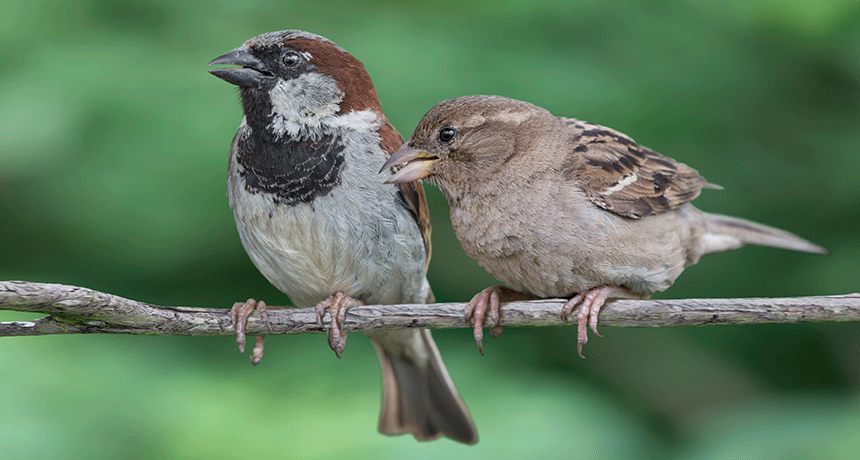Light at night lengthens how long birds can spread West Nile virus
Under dim light, house sparrows take longer to fight off their infection

Another reason for caution in lighting up the night: Study finds it makes it harder for house sparrows to fight off West Nile virus. Mosquitoes can then bite infected birds and later spread the virus to people.
PaulFleet/iStockphoto
By Susan Milius
SAN FRANCISCO, Calif. — In many places, a moonless night sky is no longer inky black. Artificial lighting can give the night a persistent glow. This so-called light pollution can affect animals. And new data now suggest those effects might trickle through ecosystems.
Even moderate light pollution, a new study finds, can roughly double how long a house sparrow infected with West Nile virus remains at high risk of spreading disease. If bitten by a mosquito, that virus can now spread to other animals, including people.
In the United States, house sparrows are about as widespread as is artificial lighting. So they made a useful test species in a new first-of-its-kind study, says Meredith Kernbach. Her team used these birds to test whether light at night might affect the spread of West Nile disease. Kernbach’s work combines ecology with the study of immune systems. She works at the University of South Florida in Tampa.
For the new study, she brought sparrows into the lab. Some spent the night in an area that was dimly lit. These birds were slower in fighting off West Nile infections than were lab sparrows that spent the night in full darkness. Kernbach reported her findings here, January 7, at the annual meeting of the Society for Integrative and Comparative Biology.
The West Nile virus needs a mosquito to spread from bird to bird, or from bird to human. If a mosquito doesn’t pick up enough of the virus from the blood of an infected animal, its new victim might be able to avoid getting sick. That’s why it matters how much virus an infected bird had coursing through its veins.
Sparrows kept under a dim night light typically had enough virus in their blood to be a potent source of virus for at least four days, Kernbach reports. Sparrows housed in full darkness had enough virus to only spread the disease for two days.
This doubling of how long a sparrow could pass along a big dose of virus might up the chance that mosquitoes will be able to spread the bird’s disease to others.
Scientists have been studying the effects of light pollution for years. Some have looked into whether it even affects human health. This has been a particular concern for people who work at night. Researchers also have looked at possible impacts on wildlife behaviors and reproduction.
Jenny Ouyang works at the University of Nevada, Reno. She, too, has studied light pollution and birds. Kernbach’s project opens new territory, Ouyang says. As light-pollution studies go, “I don’t know of anything like this.”
The findings heighten her curiosity about whether light at night might have a similar effect in spreading malaria. It, too, is a mosquito-borne disease. There have been hints in other studies, Ouyang says, that mosquitoes may sometimes be drawn to light sources. If true, night lights may boost risks of certain infectious diseases in urban areas.
Kernbach based much of her lab test on real-world conditions. The dose of virus that she gave the birds was enough to kill about 40 percent of them. That was well within what a mosquito might pick up as a vampire of birds or mammals. She used white incandescent bulbs. Used widely throughout the last century, these bulbs are still common, despite big inroads by fluorescent and LED lighting. The sparrows encountered about 8 lux of light during their seven-hour nights. (A heavily overcast day, by comparison, ranks at about 100 lux.)
What lights do to the birds is only part of the story, points out Davide Dominoni. He’s a physiologist at the Netherlands Institute of Ecology in Wageningen. Researchers will also need to look for effects on the virus itself, he says. And — of course — in the mosquitoes.







